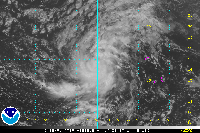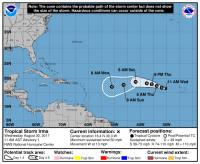Major Hurricane Irma
Tropical storm Irma was the first tropical storm to form very close to Cape Verde in the 2017 season. Irma formed as a 50 mph tropical storm with a 1006 mb pressure at the first advisory, before jumping to 60 mph 6 hours later.
The next day, Irma had strengthened into a strong tropical storm at the 5 AM advisory, with winds of 70 mph. By the next one at 11 AM, Irma had rapidly intensified into a category 2 100 mph 979 mb hurricane due to its small size. Irma jumped up to major hurricane status quickly at the 5 PM advisory the same day with winds of 115 mph and a pressure of 967 mb.
After that, Irma Rapidly intensified into a category 5, and didn't stop there. It went on and became the second strongest storm in history with winds of 185 mph and a pressure of 916 on September 5, 2017. Irma continued to break records being the strongest storm ever in the Atlantic Basin since the others were all Caribbean storms. Irma continued onward just north of Hispaniola as a category 5 hurricane before weakening to a strong category 4, then becoming a 5 at landfall in Cuba. Irma weakened into a category 4 before hitting the Florida Keys and then weakened into a category 3 at final landfall.
At the 11 pm advisory on September 11, 2017, Irma became a tropical depression and had its last NHC advisory. The next day, Irma dissipated after advisory 55 from the WPC, at 5 pm.
Impacts
Irma made landfall in the Northern Antilles as a major cat 5 with winds of 185 mph and caused hurricane warnings to be issued for the Northern Islands and every Island in its path.
After becoming a Category 5, Irma devastated islands like Barbuda and the US and British Virgin islands as well as other islands in the area, causing many deaths and entire islands to be damaged. Barbuda suffered a 95 percent loss of all structures and vehicles after landfall. Irma continued to cause hurricane warnings to be issued all along the Bahamas and Cuba and well into Florida and South Georgia as it made its way along the path. After weakening a bit, then restrengthening, Irma made landfall in Cuba as a category 5 before weakening to a category 4 again.
Irma caused damage and a heavy storm surge to the Florida Keys and to the coast of Florida as well as several fatalities across its path. After landfall, Irma caused power outages and trees to be blown down across the state of Florida and Georgia as it made its way northward, dumping inches of rain across the areas. Irma had tropical storm warnings issued across all of Northern Georgia and Eastern Alabama as it made its way northward, and High wind warnings in South Carolina.
Tornadoes were a problem in South Carolina and Florida, with many rotating cells making their way into the coasts of SC, GA, and FL as Irma moved.
Here are the messages the NHC made about Irma's exact landfalls :
…IRMA MAKES LANDFALL AT CUDJOE KEY IN LOWER FLORIDA KEYS…
The center of Hurricane Irma made landfall at Cudjoe Key in the lower Florida Keys at 9:10 am EDT. A gust to 106 mph (171 km/h) was just reported at the National Key Deer Refuge in Big Pine Key.
..CENTER OF HURRICANE IRMA MAKES LANDFALL AT MARCO ISLAND…
The center of Hurricane Irma made landfall in Marco Island in southwest Florida at 3:35 pm EDT as a Category 3 hurricane. A 130 mph wind gust was recently reported by the Marco Island Police Department.
Irma killed a total of 70 people, 26 from the US.
Which Model Won?
- ECMWF - Powerful Category 3 to 5 just north of Greater Antilles, possibly into Florida. As of September 3, 2017: Modeled somewhere between OTS and NC, ensembles OTS to Gulf.
- CMC - Strong cat 2 or 3 hurricane just north of the Greater Antilles. As of September 3, 2017: Into the Mid Atlantic or NC. Strong hurricane into Miami, then into NC up into the Mid Atlantic.
- GFS - Strong hurricane, possibly cat 4 to 5 but out to sea or close or into the East Coast. As of September 3, 2017: Into NC or the Mid Atlantic, with ensembles into Florida to NE, strong cat 4 or 5. Strong Major hurricane, likely 3 to 5 into Savannah.
- UKMET - Tropical storm to Strong 960mb hurricane over entire first run. As of September 3, 2017: South and right north of the Antilles, as a strong cat 4 or 5. Hits Hilton Head as cat 4 or 5.
- HWRF - Developed the storm into a Cat 3 crossing the Atlantic. As of September 3, 2017: Just north of the Antilles as a cat 4. Sep 6: Went up offshore into South Carolina as a cat 2 to 4.
- HMON - Developed the storm into a Cat 4 crossing the Atlantic. As of September 3, 2017: Further north than overall guidance, strong cat 4 or 5. Sep 6: Went into Miami, up spine of Florida as a 2 or 3 after a hit as a 5.
End Result:
- Long - medium range : UKMET - The UKMET was the first model to consistently hit the US, while many went OTS and further away. The ECMWF kept recurving the storm too much in its longer range, and the GFS and CMC had a huge range of solutions.
- Short Range : HMON - The HMON did just barely better than the HWRF by indicating a Cuban landfall before any other model and then up into Florida before the others, and the HWRF was slower with development overall and failed to predict a monster cat 5 in the Antilles region.
- Strength : HMON - Easily beat the HWRF and every other model by creating a monster cat 5 first, but went over a few times too much. The HWRF was much weaker than the HMON was stronger.

